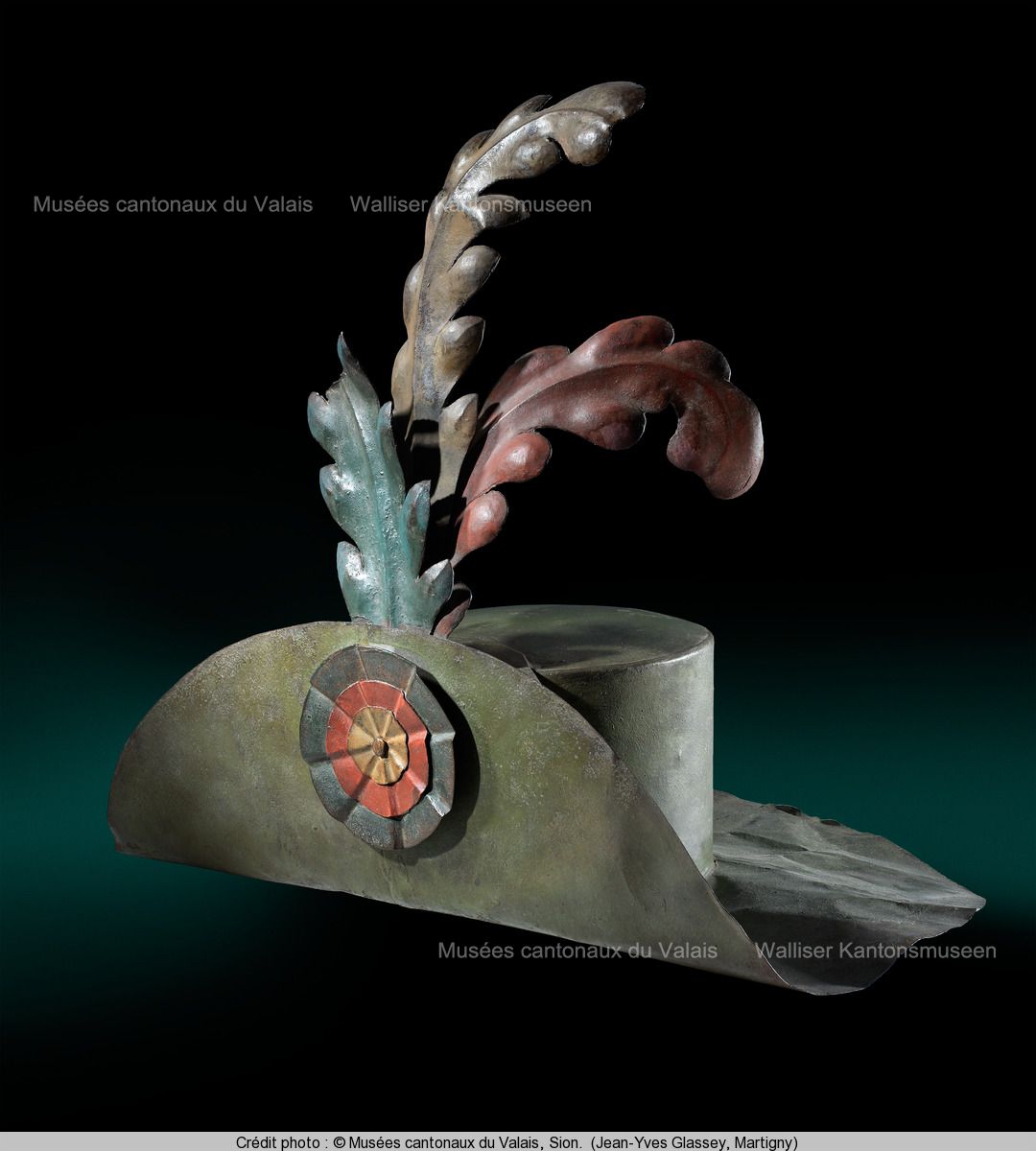Chapeau de la liberté

Marie Claude Morand, 2013 :
Planté le samedi 10 mars 1798 à Sion, l’arbre de la liberté portait peut-être ce chapeau de fer, emblème révolutionnaire aux couleurs de la République helvétique, nouvelle entité créée au sortir de la Révolution et dont le Valais fit un moment partie. On ignore si pareils chapeaux ornaient les arbres de la liberté plantés auparavant dans le Bas-Valais. À Monthey, un drapeau vert, blanc et rouge (le blanc et le jaune sont équivalents) surmontait l’arbre. Ce sont les couleurs arborées en 1790 déjà lors du soulèvement populaire contre la domination haut-valaisanne. Le vert vient probablement de la cocarde française portée lors de la prise de la Bastille. Le rouge et le blanc (jaune) renvoient moins aux couleurs du Valais et du souverain haut-valaisan qu’aux armoiries de la Savoie. Les années de dépendance savoyarde, qui durent jusqu’au début du XVIe siècle, sont restées dans les mémoires comme une période heureuse que les soulevés de la fin du XVIIIe siècle espéraient retrouver. Malheureusement, les registres d’entrée du musée sont peu bavards sur les questions de provenance, et les Mémoires du chanoine de Rivaz, s’ils retracent l’épisode de la plantation de l’arbre, ne le décrivent point.
En usage dès le printemps 1798 chez les adeptes du « nouvel ordre de choses », la cocarde devint obligatoire dès la promulgation de la loi du 12 juin 1798 stipulant « que chaque citoyen suisse soit astreint à porter la cocarde nationale aux trois couleurs helvétiques ».
"Chapeau de la liberté", in: Elsig Patrick, Morand Marie Claude (sous la dir.), Le Musée d’histoire du Valais, Sion. Collectionner au cœur des Alpes, Sion: Musée d’histoire/Paris: Somogy Ed. d’Art, 2013, pp. 210-211.
Marie Claude Morand, 2013 :
Der am Samstag, 10. März 1798 in Sitten aufgestellte Freiheitsbaum trug vielleicht diesen Blechhut in den Farben der Helvetischen Republik, also jener politischen Einheit, die aus der Revolution hervorgegangen war und der auch das Wallis eine Zeitlang angehörte. Hüte dieser Art stellten ein beliebtes Revolutionssymbol dar. Doch ist unbekannt, ob solche Hüte Freiheitsbäume schmückten, wie sie kurz zuvor im Unterwallis gepflanzt worden waren. Leider finden sich im Eingangsregister des Museums keine präzisen Angaben zur Herkunft dieses Hutes. Auch Domherr de Rivaz beschreibt ihn in seiner Schilderung über die Errichtung eines Freiheitsbaums in Sitten nicht.
In Monthey flatterte eine Fahne in den Farben grün, weiß, rot (weiß und gelb sind identisch) über dem Freiheitsbaum. Die gleichen Farben symbolisierten bereits den Aufstand von 1790 gegen die Oberwalliser Herrschaft. Das Grün kommt vermutlich von der französischen Kokarde, welche anlässlich des Sturms auf die Bastille angesteckt worden war. Rot und weiß (gelb) dürften weniger mit den Walliser (beziehungsweise Oberwalliser) Farben in einem Zusammenhang stehen, als vielmehr mit dem Wappen von Savoyen. Unter der Herrschaft Savoyens, die bis zum frühen 16. Jahrhundert andauerte, vermeinten die Unterwalliser, die sich 1790 ein erstes Mal erhoben hatten, eine freiere Zeit erlebt zu haben, die sie nun wieder zu erringen hofften.
Die Kokarde war bei den Anhängern der neuen Ordnung seit Frühjahr 1798 in Gebrauch. Am 12. Juni 1798 wurde dann das Tragen der Nationalkokarde mit den drei Farben der Helvetik zur gesetzlich verordneten Bürgerpflicht
"Freiheitshut", in: Elsig Patrick, Morand Marie Claude (Hrsg.), Das Geschichtsmuseum Wallis, Sitten. Sammeln inmitten der Alpen, Sitten: Geschichtsmuseum Wallis/Paris: Somogy Ed. d’Art, 2013, S. 210-211.
Marie Claude Morand, 2013 :
The liberty tree planted on Saturday 10 March 1798 in Sion may have been decorated with this metal hat. It is a revolutionary emblem with the colours of the Helvetian Republic, which was established after the French Revolution and to which the Valais belonged for a time. We do not know if similar hats decorated the liberty trees planted before in the Lower Valais. A green, white and red hat (white and yellow were equivalent) crowned the tree planted at Monthey. These were the colours worn during the popular uprising of 1790 against the rule of the Upper Valais. The green was probably taken over from the French cockade worn at the storming of the Bastille. The red and the white (yellow) refer less to the colours of the Valais and the sovereign Upper Valais than to the coat-of-arms of the House of Savoy. The years of dependency on Savoy were remembered as a period of prosperity that the late-18th century insurrectionists hoped to reinstate.
The museum registers are not very informative as to provenance, and although the planting of the tree is mentioned in the memoirs of the Canon of Rivaz, the hat is not.
The cockade, used in the spring of 1798 by the supporters of the “New Order”, was made mandatory by the law of 12 June 1798, which stipulated that “every Swiss citizen be obliged to wear the national cockade with the three Helvetian colours”.
"Liberty Hat", in: Elsig Patrick, Morand Marie Claude (Ed.), History Museum of Valais, Sion. Collecting in the heart of the Alps, Sion: Musée d’histoire/Paris: Somogy Ed. d’Art, 2013, pp. 210-211.

